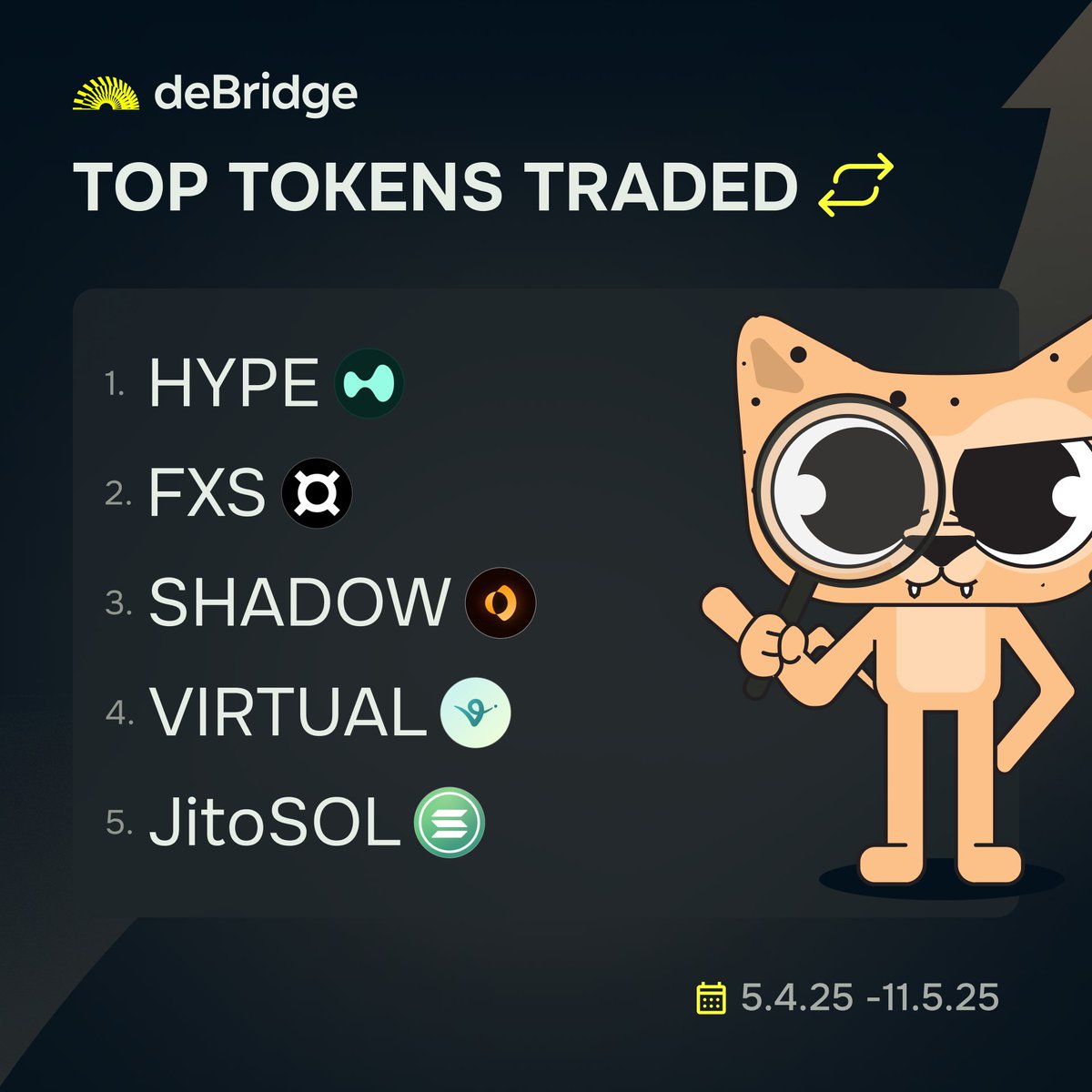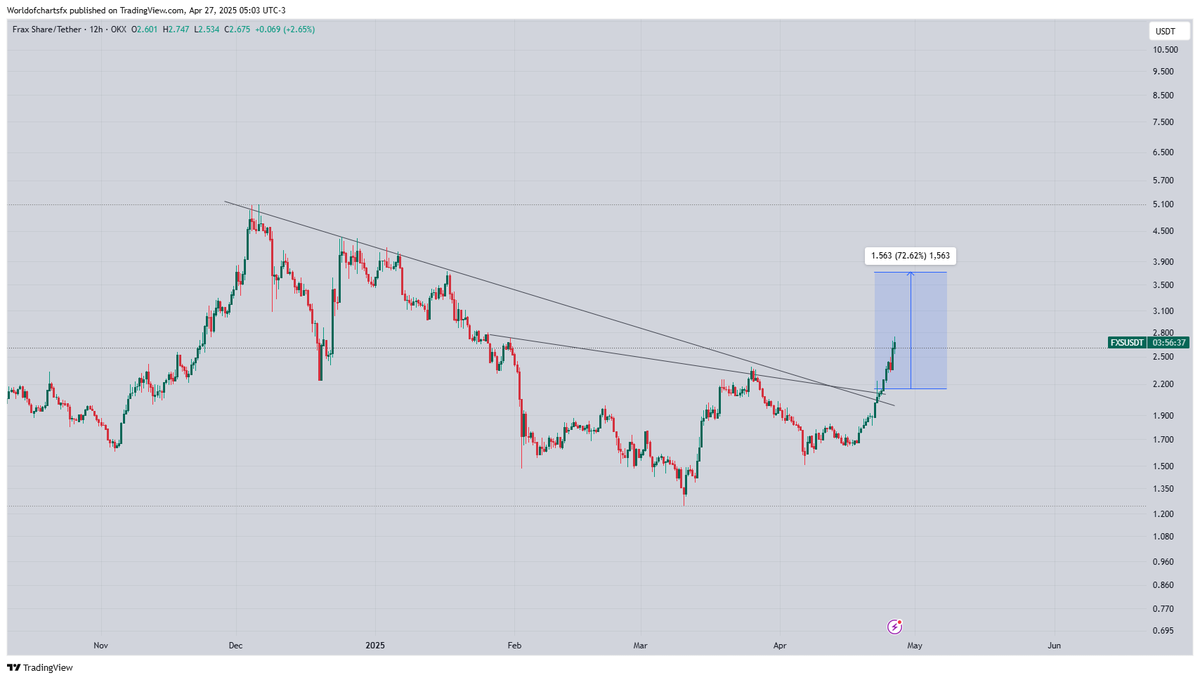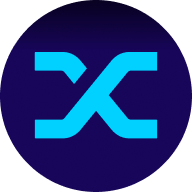
FXS
Cours du Frax Share
$3,0200
+$0,0040000
(+0,13 %)
Évolution du cours sur les dernières 24 heures

Que ressentez-vous pour FXS aujourd’hui ?
Donnez votre avis en ajoutant un pouce vers le haut si vous pensez que le cours Ethereum et la valeur Ethereum sont en hausse, ou un pouce en bas si vous estimez que le prix Ethereum et le ETH / USD vont baisser. Suivez l’évolution Ethereum en temps réel et consultez le Ethereum cours dollar et le Ethereum cours euro pour anticiper les tendances du marché.
Votez pour voir les résultats
Avis de non-responsabilité
Le contenu social sur cette page (« Contenu »), y compris mais sans s’y limiter les tweets et les statistiques fournis par LunarCrush, est issu de tiers et fourni « tel quel » à des fins d’information uniquement. OKX ne garantit ni la qualité ni l’exactitude du Contenu, et le Contenu ne représente pas les opinions d’OKX. Il n’est pas destiné à dispenser (i) des conseils ou recommandations en matière d’investissement ; il ne doit pas (ii) non plus être considéré comme une invitation à acheter, à vendre ni à détenir des actifs numériques, ni (iii) comme des conseils financiers, comptables, juridiques ou fiscaux. Les actifs numériques (dont les stablecoins et les NFT) présentent un niveau de risque élevé, et leur valeur peut varier considérablement. Les cours et les performances des actifs numériques ne sont pas garantis et peuvent changer sans préavis.</br></br>OKX ne fournit aucune recommandation en matière d’investissement ou d’actif. Évaluez attentivement votre situation financière pour déterminer si vous êtes en mesure de détenir ou de trader des actifs numériques. Demandez conseil auprès de votre expert juridique, fiscal ou en investissement pour toute question portant sur votre situation personnelle. Pour plus de détails, consultez nos <a href="/help/terms-of-service">Conditions d’utilisation</a> et notre <a href="/help/risk-compliance-disclosure">Avertissement sur les risques</a>. En utilisant le site Web tiers (« SWT »), vous acceptez que toute utilisation du SWT soit soumise et régie par les conditions du SWT. Sauf mention écrite expresse, OKX et ses sociétés affiliées (« OKX ») ne sont en aucun cas associées au propriétaire ou à l’exploitant du SWT. Vous acceptez qu’OKX ne soit responsable d’aucune perte, d’aucun dommage et d’aucune autre conséquence découlant de votre utilisation du SWT. Sachez que l’utilisation d’un SWT peut déboucher sur la perte ou la baisse de vos actifs. Le produit peut être indisponible dans certaines juridictions.
Infos sur le marché du Frax Share
Cap. boursière
La cap. boursière est calculée en multipliant l’offre en circulation d’un jeton par son dernier cours.
Cap. boursière = offre en circulation × dernier cours
Cap. boursière = offre en circulation × dernier cours
Approvisionnement en circulation
La quantité totale d’un jeton qui est accessible au public sur le marché.
Classement de cap. boursière
La position d’un jeton dans le classement par cap. boursière.
Sommet historique
Cours le plus élevé atteint par un jeton au cours de son historique de trading.
Minimum historique
Cours le plus bas atteint par un jeton au cours de son historique de trading.
Cap. boursière
$274,60M
Approvisionnement en circulation
90 507 567 FXS
90,79 % de
99 681 496 FXS
Classement de cap. boursière
--
Audits

Dernier audit : 23 mai 2021
Pic sur 24 h
$3,3100
Creux sur 24 h
$2,9960
Sommet historique
$11,0000
-72,55 % (-$7,9800)
Dernière mise à jour : 6 juil. 2023
Minimum historique
$1,2460
+142,37 % (+$1,7740)
Dernière mise à jour : 11 mars 2025
Flux de Frax Share
Le contenu suivant provient de .

Stake DAO
De nouvelles récompenses sont prêtes pour les détenteurs de Liquid Lockers, plus de 120 000 $ cette semaine :
• sdCRV : 177K
• sdBAL : 1,9 K
• sdPENDLE : 1,5 K
• sdFXS : 212
• sdFXN : 70
• sdSPECTRA : 92K
Réclamez maintenant.
Liquid Lockers : maximiser le rendement, conserver le pouvoir de gouvernance.
Afficher l’original
14,72 k
5

crv.mktcap.eth a reposté

Small Cap Scientist 👨🔬🧪🥼
$CVX en hausse de 120 % depuis le début du mois d’avril.
J’ai souligné à quel point @ConvexFinance est sous-évalué par rapport à son bilan d’actifs.
J’espère que vous avez écouté. 🎯
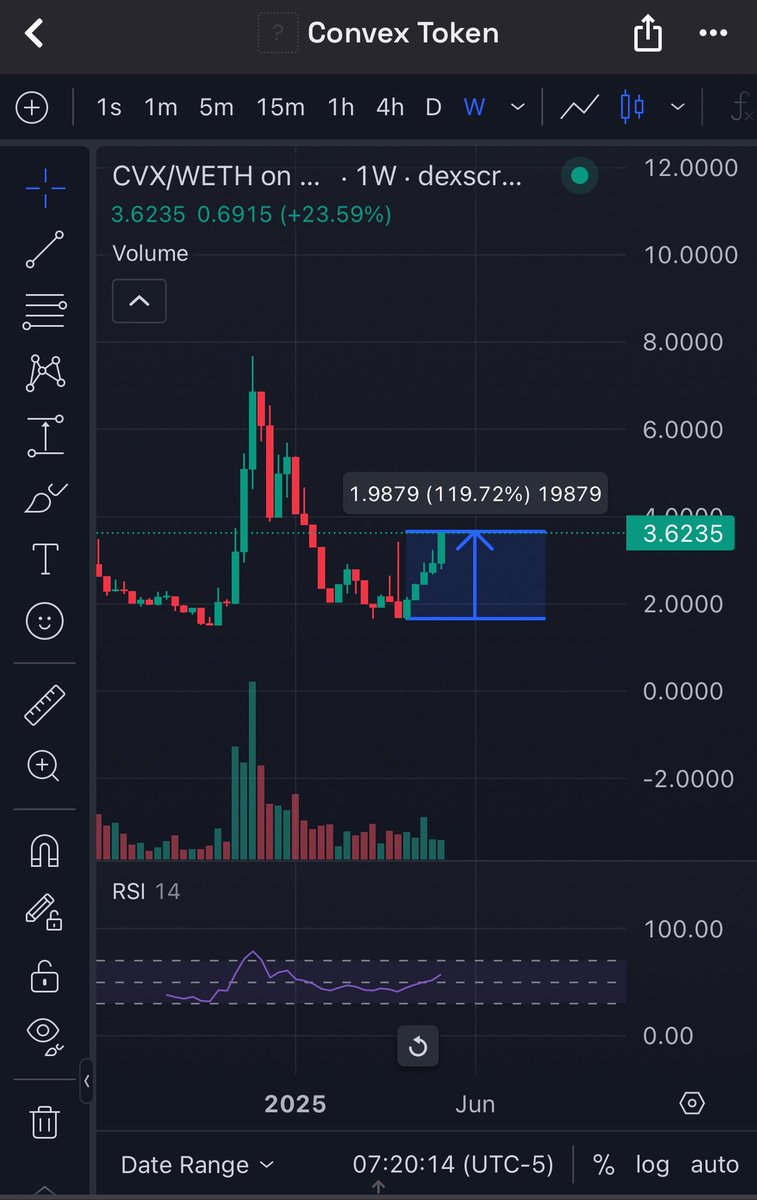

Small Cap Scientist 👨🔬🧪🥼
Regardons le bilan @ConvexFinance.
418 millions de $CRV (0,60 $) - 250,8 M$
7,45 millions de $FXS (2,25 $) - 16,76 millions de dollars
101 692 $FXN (34,26 $) - 3,48 M$
(Nous ne l’avons pas $PRISMA inclus, car ces jetons seront migrés vers Resupply.)
Total de l’actif - 271 M$
Comment cela se compare-t-il à l’évaluation convexe ?
MC convexe - 206 M$
FDV convexe -251 millions de dollars
La position $CRV convexe est de la même taille que l’ensemble du $CVX FDV.
Si vous regardez leur capitalisation boursière en circulation, ils se négocient avec une décote de 24 % par rapport à leur bilan actuel.
Ils sont également les plus grands propriétaires de $RSUP de Resupply.
Sur cinq ans, 20 % de l’offre totale de $RSUP ira à Convex Investing. $RSUP est actuellement de 2,10 $ par jeton, ce qui valoriserait la position Convex à 62 millions de dollars.
Convex était considérablement sous-évalué avant @ResupplyFi sa mise en ligne. L’ajout de Resupply à leur arsenal d’actifs fait passer $CVX pour une aubaine absolue.
En plus de fournir 20 % de l’approvisionnement $RSUP au Trésor convexe, 50 % des émissions de réapprovisionnement iront directement aux pots-de-vin.
Aux prix actuels, l’année où l’on $RSUP émissions produira à elle seule 12,6 millions de dollars en pots-de-vin pour $vlCVX.
Si vous souhaitez parier sur la croissance des stablecoins, @ConvexFinance vous expose à Frax, Curve et Resupply.
Il est difficile de battre une telle valeur dans un secteur en pleine explosion.
GL!
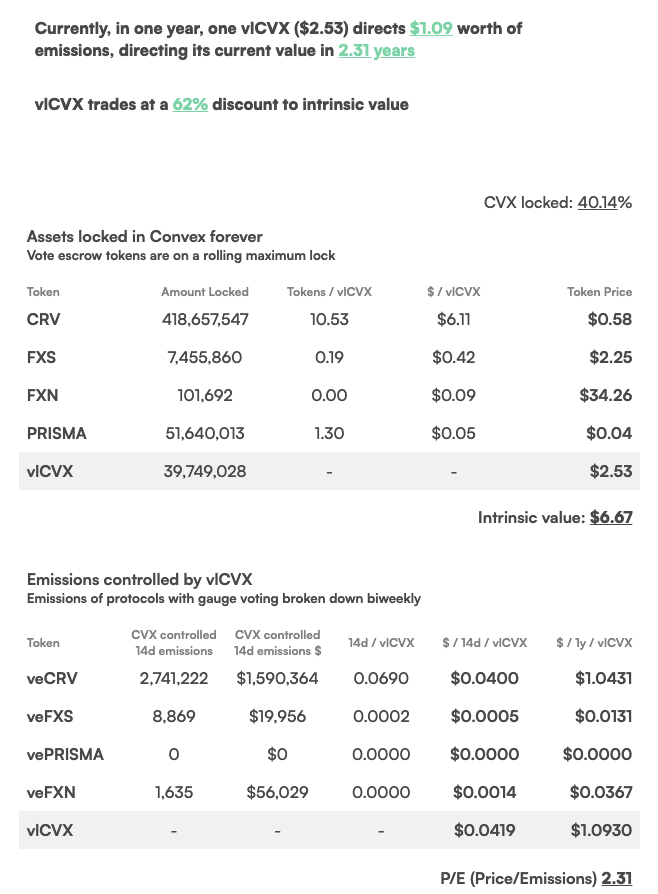

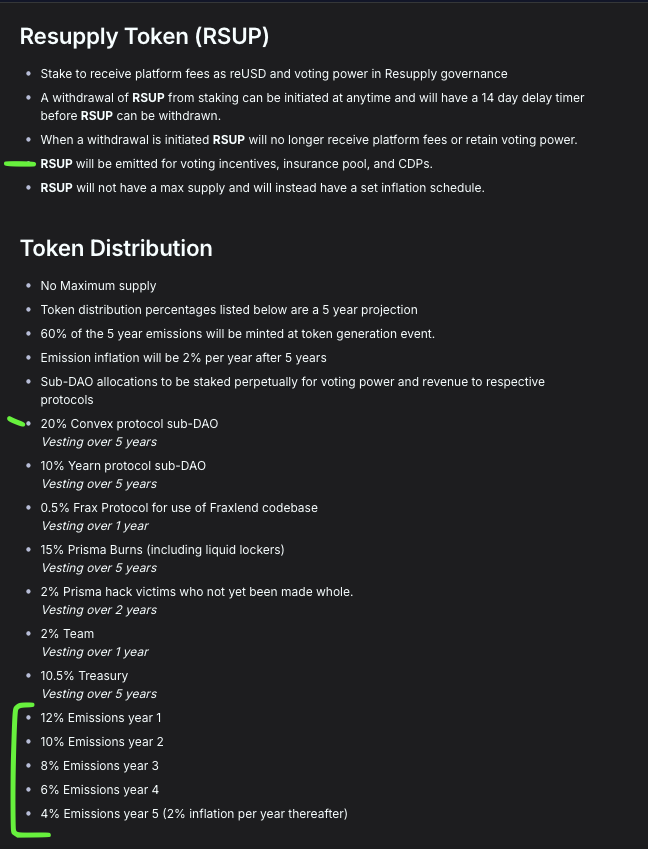
31,34 k
138
Calculateur FXS


Performance du cours de Frax Share en USD
Le cours de Frax Share est actuellement de $3,0200. Au cours des dernières 24 heures, la valeur Frax Share a a augmenté de +0,13 %. Il a actuellement une offre en circulation de 90 507 567 FXS et une offre maximale de 99 681 496 FXS, ce qui lui donne une capitalisation boursière totalement diluée de $274,60M. Actuellement, le jeton Frax Share occupe la 0 position du classement par capitalisation boursière. Le cours Frax Share/USD est mis à jour en temps réel.
Aujourd'hui
+$0,0040000
+0,13 %
7 jours
+$0,85500
+39,49 %
30 jours
+$1,3030
+75,88 %
3 mois
+$1,1800
+64,13 %
Conversions de Frax Share populaires
Dernière mise à jour : 15/05/2025 15:09
| 1 FXS en USD | 3,0340 $ |
| 1 FXS en EUR | 2,7103 € |
| 1 FXS en PHP | 169,29 ₱ |
| 1 FXS en IDR | 50 198,54 Rp |
| 1 FXS en GBP | 2,2858 £ |
| 1 FXS en CAD | 4,2399 $ |
| 1 FXS en AED | 11,1439 AED |
| 1 FXS en VND | 78 662,17 ₫ |
À propos du Frax Share (FXS)
La notation fournie correspond à une notation agrégée qui est collectée par OKX à partir des sources fournies. Elle n’est indiquée qu’à titre indicatif. OKX ne garantit ni la qualité ni l’exactitude des notations. Elle n’est pas destinée à dispenser (i) des conseils ou recommandations en matière d’investissement ; elle ne doit pas (ii) non plus être considérée comme une invitation à acheter, à vendre ni à détenir des actifs numériques, ni (iii) comme des conseils financiers, comptables, juridiques ou fiscaux. Les actifs numériques (dont les stablecoins et les NFT) présentent un niveau de risque élevé ; leur valeur peut varier considérablement, voire devenir nulle. Les prix et les performances des actifs numériques ne sont pas garantis et peuvent changer sans préavis. Vos actifs numériques ne sont pas couverts par une assurance contre les pertes potentielles. Les rendements historiques ne constituent pas un indicateur des rendements futurs. OKX ne garantit aucun rendement, ni le remboursement du capital et des intérêts. Évaluez attentivement votre situation financière pour déterminer si vous êtes en mesure de détenir des actifs numériques ou de réaliser des activités de trading. Demandez conseil auprès de votre expert juridique/fiscal/en investissement pour toute question portant sur votre propre situation.
Afficher plus
- Site web officiel
- Explorateur de blocs
À propos des sites Web tiers
À propos des sites Web tiers
En utilisant le site web tiers (« SWT »), vous acceptez que toute utilisation du SWT soit sujette aux conditions du SWT et gouvernée par celles-ci. Sauf mention écrite expresse, OKX et ses affiliés (« OKX ») ne sont en aucun cas associés au propriétaire ni à l’opérateur du SWT. Vous acceptez le fait qu’OKX ne soit pas responsable des pertes, dommages ni de toutes autres conséquences découlant de votre utilisation du SWT. Veuillez noter que l’utilisation d’un SWT peut entraîner une perte ou une diminution de vos actifs.
FAQ Frax Share
Combien vaut 1 Frax Share aujourd’hui ?
Actuellement, 1 Frax Share vaut $3,0200. Vous recherchez des informations sur les mouvements de prix du token Frax Share ? Vous êtes au bon endroit ! Découvrez les graphiques les plus récents sur le token Frax Share et tradez de manière responsable avec OKX.
Qu'est-ce que la cryptomonnaie ?
Les cryptomonnaies, telles que les Frax Share, sont des actifs numériques fonctionnant sur un registre public appelé blockchain. En savoir plus sur les jetons proposés sur OKX et leurs différents attributs, notamment le cours en direct et les graphiques en temps réel.
Quand la cryptomonnaie a-t-elle été inventée ?
En raison de la crise financière de 2008, l’intérêt porté à la finance décentralisée a explosé. Le Bitcoin offrait une solution novatrice en tant qu’actif numérique sécurisé sur un réseau décentralisé. De nombreux jetons tels que les Frax Share ont également été créés depuis lors.
Le cours du Frax Share va-t-il augmenter aujourd'hui ?
Consultez notre Page de prédiction des cours de Frax Share pour prévoir les cours à venir et déterminer vos objectifs de cours.
Déclaration ESG
Les réglementations ESG (approche environnementale, sociale et de gouvernance) relatives aux actifs crypto visent à réduire leur impact environnemental (par exemple : l'extraction minière à forte intensité énergétique), à promouvoir la transparence et à garantir des pratiques de gouvernance éthiques afin d'aligner le secteur des cryptos sur des objectifs plus larges en matière de durabilité et de société. Ces réglementations encouragent le respect de normes qui atténuent les risques et favorisent la confiance dans les actifs numériques.
Détails de l’actif
Nom
OKcoin Europe LTD
Identifiant de l’entité juridique concernée
54930069NLWEIGLHXU42
Nom de l’actif crypto
Frax Share
Mécanisme de consensus
Frax Share is present on the following networks: arbitrum, avalanche, binance_smart_chain, ethereum, fantom, solana.
Arbitrum is a Layer 2 solution on top of Ethereum that uses Optimistic Rollups to enhance scalability and reduce transaction costs. It assumes that transactions are valid by default and only verifies them if there's a challenge (optimistic): Core Components: • Sequencer: Orders transactions and creates batches for processing. • Bridge: Facilitates asset transfers between Arbitrum and Ethereum. • Fraud Proofs: Protect against invalid transactions through an interactive verification process. Verification Process: 1. Transaction Submission: Users submit transactions to the Arbitrum Sequencer, which orders and batches them. 2. State Commitment: These batches are submitted to Ethereum with a state commitment. 3. Challenge Period: Validators have a specific period to challenge the state if they suspect fraud. 4. Dispute Resolution: If a challenge occurs, the dispute is resolved through an iterative process to identify the fraudulent transaction. The final operation is executed on Ethereum to determine the correct state. 5. Rollback and Penalties: If fraud is proven, the state is rolled back, and the dishonest party is penalized. Security and Efficiency: The combination of the Sequencer, bridge, and interactive fraud proofs ensures that the system remains secure and efficient. By minimizing on-chain data and leveraging off-chain computations, Arbitrum can provide high throughput and low fees.
The Avalanche blockchain network employs a unique Proof-of-Stake consensus mechanism called Avalanche Consensus, which involves three interconnected protocols: Snowball, Snowflake, and Avalanche. Avalanche Consensus Process 1. Snowball Protocol: o Random Sampling: Each validator randomly samples a small, constant-sized subset of other validators. Repeated Polling: Validators repeatedly poll the sampled validators to determine the preferred transaction. Confidence Counters: Validators maintain confidence counters for each transaction, incrementing them each time a sampled validator supports their preferred transaction. Decision Threshold: Once the confidence counter exceeds a pre-defined threshold, the transaction is considered accepted. 2. Snowflake Protocol: Binary Decision: Enhances the Snowball protocol by incorporating a binary decision process. Validators decide between two conflicting transactions. Binary Confidence: Confidence counters are used to track the preferred binary decision. Finality: When a binary decision reaches a certain confidence level, it becomes final. 3. Avalanche Protocol: DAG Structure: Uses a Directed Acyclic Graph (DAG) structure to organize transactions, allowing for parallel processing and higher throughput. Transaction Ordering: Transactions are added to the DAG based on their dependencies, ensuring a consistent order. Consensus on DAG: While most Proof-of-Stake Protocols use a Byzantine Fault Tolerant (BFT) consensus, Avalanche uses the Avalanche Consensus, Validators reach consensus on the structure and contents of the DAG through repeated Snowball and Snowflake.
Binance Smart Chain (BSC) uses a hybrid consensus mechanism called Proof of Staked Authority (PoSA), which combines elements of Delegated Proof of Stake (DPoS) and Proof of Authority (PoA). This method ensures fast block times and low fees while maintaining a level of decentralization and security. Core Components 1. Validators (so-called “Cabinet Members”): Validators on BSC are responsible for producing new blocks, validating transactions, and maintaining the network’s security. To become a validator, an entity must stake a significant amount of BNB (Binance Coin). Validators are selected through staking and voting by token holders. There are 21 active validators at any given time, rotating to ensure decentralization and security. 2. Delegators: Token holders who do not wish to run validator nodes can delegate their BNB tokens to validators. This delegation helps validators increase their stake and improves their chances of being selected to produce blocks. Delegators earn a share of the rewards that validators receive, incentivizing broad participation in network security. 3. Candidates: Candidates are nodes that have staked the required amount of BNB and are in the pool waiting to become validators. They are essentially potential validators who are not currently active but can be elected to the validator set through community voting. Candidates play a crucial role in ensuring there is always a sufficient pool of nodes ready to take on validation tasks, thus maintaining network resilience and decentralization. Consensus Process 4. Validator Selection: Validators are chosen based on the amount of BNB staked and votes received from delegators. The more BNB staked and votes received, the higher the chance of being selected to validate transactions and produce new blocks. The selection process involves both the current validators and the pool of candidates, ensuring a dynamic and secure rotation of nodes. 5. Block Production: The selected validators take turns producing blocks in a PoA-like manner, ensuring that blocks are generated quickly and efficiently. Validators validate transactions, add them to new blocks, and broadcast these blocks to the network. 6. Transaction Finality: BSC achieves fast block times of around 3 seconds and quick transaction finality. This is achieved through the efficient PoSA mechanism that allows validators to rapidly reach consensus. Security and Economic Incentives 7. Staking: Validators are required to stake a substantial amount of BNB, which acts as collateral to ensure their honest behavior. This staked amount can be slashed if validators act maliciously. Staking incentivizes validators to act in the network's best interest to avoid losing their staked BNB. 8. Delegation and Rewards: Delegators earn rewards proportional to their stake in validators. This incentivizes them to choose reliable validators and participate in the network’s security. Validators and delegators share transaction fees as rewards, which provides continuous economic incentives to maintain network security and performance. 9. Transaction Fees: BSC employs low transaction fees, paid in BNB, making it cost-effective for users. These fees are collected by validators as part of their rewards, further incentivizing them to validate transactions accurately and efficiently.
The Ethereum network uses a Proof-of-Stake Consensus Mechanism to validate new transactions on the blockchain. Core Components 1. Validators: Validators are responsible for proposing and validating new blocks. To become a validator, a user must deposit (stake) 32 ETH into a smart contract. This stake acts as collateral and can be slashed if the validator behaves dishonestly. 2. Beacon Chain: The Beacon Chain is the backbone of Ethereum 2.0. It coordinates the network of validators and manages the consensus protocol. It is responsible for creating new blocks, organizing validators into committees, and implementing the finality of blocks. Consensus Process 1. Block Proposal: Validators are chosen randomly to propose new blocks. This selection is based on a weighted random function (WRF), where the weight is determined by the amount of ETH staked. 2. Attestation: Validators not proposing a block participate in attestation. They attest to the validity of the proposed block by voting for it. Attestations are then aggregated to form a single proof of the block’s validity. 3. Committees: Validators are organized into committees to streamline the validation process. Each committee is responsible for validating blocks within a specific shard or the Beacon Chain itself. This ensures decentralization and security, as a smaller group of validators can quickly reach consensus. 4. Finality: Ethereum 2.0 uses a mechanism called Casper FFG (Friendly Finality Gadget) to achieve finality. Finality means that a block and its transactions are considered irreversible and confirmed. Validators vote on the finality of blocks, and once a supermajority is reached, the block is finalized. 5. Incentives and Penalties: Validators earn rewards for participating in the network, including proposing blocks and attesting to their validity. Conversely, validators can be penalized (slashed) for malicious behavior, such as double-signing or being offline for extended periods. This ensures honest participation and network security.
Fantom operates on the Lachesis Protocol, an Asynchronous Byzantine Fault Tolerant (aBFT) consensus mechanism designed for fast, secure, and scalable transactions. Core Components of Fantom’s Consensus: 1. Lachesis Protocol (aBFT): Asynchronous and Leaderless: Lachesis allows nodes to reach consensus independently without relying on a central leader, enhancing decentralization and speed. DAG Structure: Instead of a linear blockchain, Lachesis uses a Directed Acyclic Graph (DAG) structure, allowing multiple transactions to be processed in parallel across nodes. This structure supports high throughput, making the network suitable for applications requiring rapid transaction processing. 2. Event Blocks and Instant Finality: Event Blocks: Transactions are grouped into event blocks, which are validated asynchronously by multiple validators. When enough validators confirm an event block, it becomes part of the Fantom network’s history. Instant Finality: Transactions on Fantom achieve immediate finality, meaning they are confirmed and cannot be reversed. This property is ideal for applications requiring fast and irreversible transactions.
Solana uses a unique combination of Proof of History (PoH) and Proof of Stake (PoS) to achieve high throughput, low latency, and robust security. Here’s a detailed explanation of how these mechanisms work: Core Concepts 1. Proof of History (PoH): Time-Stamped Transactions: PoH is a cryptographic technique that timestamps transactions, creating a historical record that proves that an event has occurred at a specific moment in time. Verifiable Delay Function: PoH uses a Verifiable Delay Function (VDF) to generate a unique hash that includes the transaction and the time it was processed. This sequence of hashes provides a verifiable order of events, enabling the network to efficiently agree on the sequence of transactions. 2. Proof of Stake (PoS): Validator Selection: Validators are chosen to produce new blocks based on the number of SOL tokens they have staked. The more tokens staked, the higher the chance of being selected to validate transactions and produce new blocks. Delegation: Token holders can delegate their SOL tokens to validators, earning rewards proportional to their stake while enhancing the network's security. Consensus Process 1. Transaction Validation: Transactions are broadcast to the network and collected by validators. Each transaction is validated to ensure it meets the network’s criteria, such as having correct signatures and sufficient funds. 2. PoH Sequence Generation: A validator generates a sequence of hashes using PoH, each containing a timestamp and the previous hash. This process creates a historical record of transactions, establishing a cryptographic clock for the network. 3. Block Production: The network uses PoS to select a leader validator based on their stake. The leader is responsible for bundling the validated transactions into a block. The leader validator uses the PoH sequence to order transactions within the block, ensuring that all transactions are processed in the correct order. 4. Consensus and Finalization: Other validators verify the block produced by the leader validator. They check the correctness of the PoH sequence and validate the transactions within the block. Once the block is verified, it is added to the blockchain. Validators sign off on the block, and it is considered finalized. Security and Economic Incentives 1. Incentives for Validators: Block Rewards: Validators earn rewards for producing and validating blocks. These rewards are distributed in SOL tokens and are proportional to the validator’s stake and performance. Transaction Fees: Validators also earn transaction fees from the transactions included in the blocks they produce. These fees provide an additional incentive for validators to process transactions efficiently. 2. Security: Staking: Validators must stake SOL tokens to participate in the consensus process. This staking acts as collateral, incentivizing validators to act honestly. If a validator behaves maliciously or fails to perform, they risk losing their staked tokens. Delegated Staking: Token holders can delegate their SOL tokens to validators, enhancing network security and decentralization. Delegators share in the rewards and are incentivized to choose reliable validators. 3. Economic Penalties: Slashing: Validators can be penalized for malicious behavior, such as double-signing or producing invalid blocks. This penalty, known as slashing, results in the loss of a portion of the staked tokens, discouraging dishonest actions.
Mécanismes d’incitation et frais applicables
Frax Share is present on the following networks: arbitrum, avalanche, binance_smart_chain, ethereum, fantom, solana.
Arbitrum One, a Layer 2 scaling solution for Ethereum, employs several incentive mechanisms to ensure the security and integrity of transactions on its network. The key mechanisms include: 1. Validators and Sequencers: o Sequencers are responsible for ordering transactions and creating batches that are processed off-chain. They play a critical role in maintaining the efficiency and throughput of the network. o Validators monitor the sequencers' actions and ensure that transactions are processed correctly. Validators verify the state transitions and ensure that no invalid transactions are included in the batches. 2. Fraud Proofs: o Assumption of Validity: Transactions processed off-chain are assumed to be valid. This allows for quick transaction finality and high throughput. o Challenge Period: There is a predefined period during which anyone can challenge the validity of a transaction by submitting a fraud proof. This mechanism acts as a deterrent against malicious behavior. o Dispute Resolution: If a challenge is raised, an interactive verification process is initiated to pinpoint the exact step where fraud occurred. If the challenge is valid, the fraudulent transaction is reverted, and the dishonest actor is penalized. 3. Economic Incentives: o Rewards for Honest Behavior: Participants in the network, such as validators and sequencers, are incentivized through rewards for performing their duties honestly and efficiently. These rewards come from transaction fees and potentially other protocol incentives. o Penalties for Malicious Behavior: Participants who engage in dishonest behavior or submit invalid transactions are penalized. This can include slashing of staked tokens or other forms of economic penalties, which serve to discourage malicious actions. Fees on the Arbitrum One Blockchain 1. Transaction Fees: o Layer 2 Fees: Users pay fees for transactions processed on the Layer 2 network. These fees are typically lower than Ethereum mainnet fees due to the reduced computational load on the main chain. o Arbitrum Transaction Fee: A fee is charged for each transaction processed by the sequencer. This fee covers the cost of processing the transaction and ensuring its inclusion in a batch. 2. L1 Data Fees: o Posting Batches to Ethereum: Periodically, the state updates from the Layer 2 transactions are posted to the Ethereum mainnet as calldata. This involves a fee, known as the L1 data fee, which accounts for the gas required to publish these state updates on Ethereum. o Cost Sharing: Because transactions are batched, the fixed costs of posting state updates to Ethereum are spread across multiple transactions, making it more cost-effective for users.
Avalanche uses a consensus mechanism known as Avalanche Consensus, which relies on a combination of validators, staking, and a novel approach to consensus to ensure the network's security and integrity. Validators: Staking: Validators on the Avalanche network are required to stake AVAX tokens. The amount staked influences their probability of being selected to propose or validate new blocks. Rewards: Validators earn rewards for their participation in the consensus process. These rewards are proportional to the amount of AVAX staked and their uptime and performance in validating transactions. Delegation: Validators can also accept delegations from other token holders. Delegators share in the rewards based on the amount they delegate, which incentivizes smaller holders to participate indirectly in securing the network. 2. Economic Incentives: Block Rewards: Validators receive block rewards for proposing and validating blocks. These rewards are distributed from the network’s inflationary issuance of AVAX tokens. Transaction Fees: Validators also earn a portion of the transaction fees paid by users. This includes fees for simple transactions, smart contract interactions, and the creation of new assets on the network. 3. Penalties: Slashing: Unlike some other PoS systems, Avalanche does not employ slashing (i.e., the confiscation of staked tokens) as a penalty for misbehavior. Instead, the network relies on the financial disincentive of lost future rewards for validators who are not consistently online or act maliciously. o Uptime Requirements: Validators must maintain a high level of uptime and correctly validate transactions to continue earning rewards. Poor performance or malicious actions result in missed rewards, providing a strong economic incentive to act honestly. Fees on the Avalanche Blockchain 1. Transaction Fees: Dynamic Fees: Transaction fees on Avalanche are dynamic, varying based on network demand and the complexity of the transactions. This ensures that fees remain fair and proportional to the network's usage. Fee Burning: A portion of the transaction fees is burned, permanently removing them from circulation. This deflationary mechanism helps to balance the inflation from block rewards and incentivizes token holders by potentially increasing the value of AVAX over time. 2. Smart Contract Fees: Execution Costs: Fees for deploying and interacting with smart contracts are determined by the computational resources required. These fees ensure that the network remains efficient and that resources are used responsibly. 3. Asset Creation Fees: New Asset Creation: There are fees associated with creating new assets (tokens) on the Avalanche network. These fees help to prevent spam and ensure that only serious projects use the network's resources.
Binance Smart Chain (BSC) uses the Proof of Staked Authority (PoSA) consensus mechanism to ensure network security and incentivize participation from validators and delegators. Incentive Mechanisms 1. Validators: Staking Rewards: Validators must stake a significant amount of BNB to participate in the consensus process. They earn rewards in the form of transaction fees and block rewards. Selection Process: Validators are selected based on the amount of BNB staked and the votes received from delegators. The more BNB staked and votes received, the higher the chances of being selected to validate transactions and produce new blocks. 2. Delegators: Delegated Staking: Token holders can delegate their BNB to validators. This delegation increases the validator's total stake and improves their chances of being selected to produce blocks. Shared Rewards: Delegators earn a portion of the rewards that validators receive. This incentivizes token holders to participate in the network’s security and decentralization by choosing reliable validators. 3. Candidates: Pool of Potential Validators: Candidates are nodes that have staked the required amount of BNB and are waiting to become active validators. They ensure that there is always a sufficient pool of nodes ready to take on validation tasks, maintaining network resilience. 4. Economic Security: Slashing: Validators can be penalized for malicious behavior or failure to perform their duties. Penalties include slashing a portion of their staked tokens, ensuring that validators act in the best interest of the network. Opportunity Cost: Staking requires validators and delegators to lock up their BNB tokens, providing an economic incentive to act honestly to avoid losing their staked assets. Fees on the Binance Smart Chain 5. Transaction Fees: Low Fees: BSC is known for its low transaction fees compared to other blockchain networks. These fees are paid in BNB and are essential for maintaining network operations and compensating validators. Dynamic Fee Structure: Transaction fees can vary based on network congestion and the complexity of the transactions. However, BSC ensures that fees remain significantly lower than those on the Ethereum mainnet. 6. Block Rewards: Incentivizing Validators: Validators earn block rewards in addition to transaction fees. These rewards are distributed to validators for their role in maintaining the network and processing transactions. 7. Cross-Chain Fees: Interoperability Costs: BSC supports cross-chain compatibility, allowing assets to be transferred between Binance Chain and Binance Smart Chain. These cross-chain operations incur minimal fees, facilitating seamless asset transfers and improving user experience. 8. Smart Contract Fees: Deployment and Execution Costs: Deploying and interacting with smart contracts on BSC involves paying fees based on the computational resources required. These fees are also paid in BNB and are designed to be cost-effective, encouraging developers to build on the BSC platform.
Ethereum, particularly after transitioning to Ethereum 2.0 (Eth2), employs a Proof-of-Stake (PoS) consensus mechanism to secure its network. The incentives for validators and the fee structures play crucial roles in maintaining the security and efficiency of the blockchain. Incentive Mechanisms 1. Staking Rewards: Validator Rewards: Validators are essential to the PoS mechanism. They are responsible for proposing and validating new blocks. To participate, they must stake a minimum of 32 ETH. In return, they earn rewards for their contributions, which are paid out in ETH. These rewards are a combination of newly minted ETH and transaction fees from the blocks they validate. Reward Rate: The reward rate for validators is dynamic and depends on the total amount of ETH staked in the network. The more ETH staked, the lower the individual reward rate, and vice versa. This is designed to balance the network's security and the incentive to participate. 2. Transaction Fees: Base Fee: After the implementation of Ethereum Improvement Proposal (EIP) 1559, the transaction fee model changed to include a base fee that is burned (i.e., removed from circulation). This base fee adjusts dynamically based on network demand, aiming to stabilize transaction fees and reduce volatility. Priority Fee (Tip): Users can also include a priority fee (tip) to incentivize validators to include their transactions more quickly. This fee goes directly to the validators, providing them with an additional incentive to process transactions efficiently. 3. Penalties for Malicious Behavior: Slashing: Validators face penalties (slashing) if they engage in malicious behavior, such as double-signing or validating incorrect information. Slashing results in the loss of a portion of their staked ETH, discouraging bad actors and ensuring that validators act in the network's best interest. Inactivity Penalties: Validators also face penalties for prolonged inactivity. This ensures that validators remain active and engaged in maintaining the network's security and operation. Fees Applicable on the Ethereum Blockchain 1. Gas Fees: Calculation: Gas fees are calculated based on the computational complexity of transactions and smart contract executions. Each operation on the Ethereum Virtual Machine (EVM) has an associated gas cost. Dynamic Adjustment: The base fee introduced by EIP-1559 dynamically adjusts according to network congestion. When demand for block space is high, the base fee increases, and when demand is low, it decreases. 2. Smart Contract Fees: Deployment and Interaction: Deploying a smart contract on Ethereum involves paying gas fees proportional to the contract's complexity and size. Interacting with deployed smart contracts (e.g., executing functions, transferring tokens) also incurs gas fees. Optimizations: Developers are incentivized to optimize their smart contracts to minimize gas usage, making transactions more cost-effective for users. 3. Asset Transfer Fees: Token Transfers: Transferring ERC-20 or other token standards involves gas fees. These fees vary based on the token's contract implementation and the current network demand.
Fantom’s incentive model promotes network security through staking rewards, transaction fees, and delegation options, encouraging broad participation. Incentive Mechanisms: 1. Staking Rewards for Validators: Earning Rewards in FTM: Validators who participate in the consensus process earn rewards in FTM tokens, proportional to the amount they have staked. This incentivizes validators to actively secure the network. Dynamic Staking Rate: Fantom’s staking reward rate is dynamic, adjusting based on total FTM staked across the network. As more FTM is staked, individual rewards may decrease, maintaining a balanced reward structure that supports long-term network security. 2. Delegation for Token Holders: Delegated Staking: Users who do not operate validator nodes can delegate their FTM tokens to validators. In return, they share in the staking rewards, encouraging wider participation in securing the network. Applicable Fees: • Transaction Fees in FTM: Users pay transaction fees in FTM tokens. The network’s high throughput and DAG structure keep fees low, making Fantom ideal for decentralized applications (dApps) requiring frequent transactions. • Efficient Fee Model: The low fees and scalability of the network make it cost-effective for users, fostering a favorable environment for high-volume applications.
Solana uses a combination of Proof of History (PoH) and Proof of Stake (PoS) to secure its network and validate transactions. Here’s a detailed explanation of the incentive mechanisms and applicable fees: Incentive Mechanisms 4. Validators: Staking Rewards: Validators are chosen based on the number of SOL tokens they have staked. They earn rewards for producing and validating blocks, which are distributed in SOL. The more tokens staked, the higher the chances of being selected to validate transactions and produce new blocks. Transaction Fees: Validators earn a portion of the transaction fees paid by users for the transactions they include in the blocks. This provides an additional financial incentive for validators to process transactions efficiently and maintain the network's integrity. 5. Delegators: Delegated Staking: Token holders who do not wish to run a validator node can delegate their SOL tokens to a validator. In return, delegators share in the rewards earned by the validators. This encourages widespread participation in securing the network and ensures decentralization. 6. Economic Security: Slashing: Validators can be penalized for malicious behavior, such as producing invalid blocks or being frequently offline. This penalty, known as slashing, involves the loss of a portion of their staked tokens. Slashing deters dishonest actions and ensures that validators act in the best interest of the network. Opportunity Cost: By staking SOL tokens, validators and delegators lock up their tokens, which could otherwise be used or sold. This opportunity cost incentivizes participants to act honestly to earn rewards and avoid penalties. Fees Applicable on the Solana Blockchain 7. Transaction Fees: Low and Predictable Fees: Solana is designed to handle a high throughput of transactions, which helps keep fees low and predictable. The average transaction fee on Solana is significantly lower compared to other blockchains like Ethereum. Fee Structure: Fees are paid in SOL and are used to compensate validators for the resources they expend to process transactions. This includes computational power and network bandwidth. 8. Rent Fees: State Storage: Solana charges rent fees for storing data on the blockchain. These fees are designed to discourage inefficient use of state storage and encourage developers to clean up unused state. Rent fees help maintain the efficiency and performance of the network. 9. Smart Contract Fees: Execution Costs: Similar to transaction fees, fees for deploying and interacting with smart contracts on Solana are based on the computational resources required. This ensures that users are charged proportionally for the resources they consume.
Début de la période à laquelle se rapporte la déclaration
2024-04-20
Fin de la période à laquelle se rapporte la déclaration
2025-04-20
Rapport sur l'énergie
Consommation énergétique
955.61975 (kWh/a)
Sources de consommation d’énergie et méthodologies
The energy consumption of this asset is aggregated across multiple components:
To determine the energy consumption of a token, the energy consumption of the network(s) arbitrum, avalanche, binance_smart_chain, ethereum, fantom, solana is calculated first. Based on the crypto asset's gas consumption per network, the share of the total consumption of the respective network that is assigned to this asset is defined. When calculating the energy consumption, we used - if available - the Functionally Fungible Group Digital Token Identifier (FFG DTI) to determine all implementations of the asset of question in scope and we update the mappings regulary, based on data of the Digital Token Identifier Foundation.
Calculateur FXS





